
-
 Iron tsuba of round form (maru-gata) with 8 openwork petals outlined with brass wire (sen-zōgan) and decorated with brass dots (ten-zōgan), on both sides. Seppa-dai and hitsu-ana outlined with brass wire. Late Muromachi period (Ca. 1514-1573). Ōnin school. Unsigned. Dimensions (mm): 80.4 x 79.8 x 3.6 (center) 3.2 (rim). Similar tsuba in this collection: TSU-0374.2018
Iron tsuba of round form (maru-gata) with 8 openwork petals outlined with brass wire (sen-zōgan) and decorated with brass dots (ten-zōgan), on both sides. Seppa-dai and hitsu-ana outlined with brass wire. Late Muromachi period (Ca. 1514-1573). Ōnin school. Unsigned. Dimensions (mm): 80.4 x 79.8 x 3.6 (center) 3.2 (rim). Similar tsuba in this collection: TSU-0374.2018
-
 Artist: Tsukioka Tanka [旦霞] (Japanese, fl. c. 1830s – 1840s). Publisher: Enshūya Matabei [遠州屋又兵衛] (Japanese, fl. c. 1768 – 1881); seal: Enmata. Title: Picture of Fuji, Tsukuba and Sumida River [富士筑波隅田川の圖] (フジ ツクバ スミダガワ ノ ズ | Fuji Tsukuba Sumidagawa no zu). Date seal 巳 + kiwame: Tenpō 4 (1833). Media: Fan print (uchiwa-e, 団扇絵), 235 x 302 mm, aizuri-e. Only four prints are known from this artist, all fans: (1) National Diet Library 2542868:
Artist: Tsukioka Tanka [旦霞] (Japanese, fl. c. 1830s – 1840s). Publisher: Enshūya Matabei [遠州屋又兵衛] (Japanese, fl. c. 1768 – 1881); seal: Enmata. Title: Picture of Fuji, Tsukuba and Sumida River [富士筑波隅田川の圖] (フジ ツクバ スミダガワ ノ ズ | Fuji Tsukuba Sumidagawa no zu). Date seal 巳 + kiwame: Tenpō 4 (1833). Media: Fan print (uchiwa-e, 団扇絵), 235 x 302 mm, aizuri-e. Only four prints are known from this artist, all fans: (1) National Diet Library 2542868:
(2) Ritsumeikan University mai30_07:

 (3) RISD Museum 34.334:
(3) RISD Museum 34.334:

-
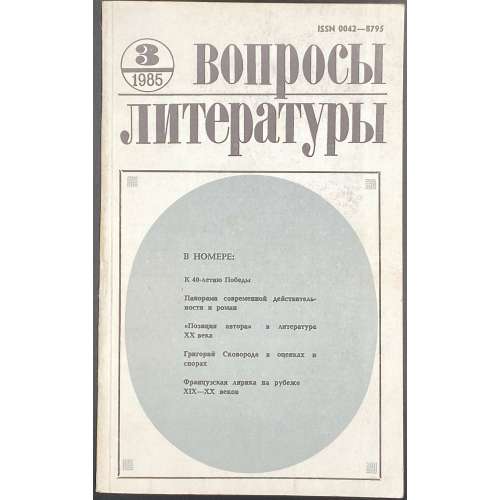 An essay by Sergei Petrovich Varshavsky [Сергей Петрович Варшавский] (Jewish-Russian, 1906 – 1980) about a poem Жди меня (Wait for Me, Zhdi menia) written by Konstantin Simonov [Константин Михайлович Симонов] (Russian, 1915 – 1979) in August 1941. Magazine, softcover, publisher’s wrappers, 20 x 12.5 cm, collated 16mo: [1]-916 (total 144 leaves), pp.: [2] 3-286 [2] (total 288 pages). Bimonthly (6 times a year) magazine "Вопросы литературы" (Questions of Literature, Voprosy literatury) published from 1957; circulation of 15,640 copies. Editor-in-Chief (1979-87): Мстислав Борисович Козьмин (Russian, 1920 – 1992).
An essay by Sergei Petrovich Varshavsky [Сергей Петрович Варшавский] (Jewish-Russian, 1906 – 1980) about a poem Жди меня (Wait for Me, Zhdi menia) written by Konstantin Simonov [Константин Михайлович Симонов] (Russian, 1915 – 1979) in August 1941. Magazine, softcover, publisher’s wrappers, 20 x 12.5 cm, collated 16mo: [1]-916 (total 144 leaves), pp.: [2] 3-286 [2] (total 288 pages). Bimonthly (6 times a year) magazine "Вопросы литературы" (Questions of Literature, Voprosy literatury) published from 1957; circulation of 15,640 copies. Editor-in-Chief (1979-87): Мстислав Борисович Козьмин (Russian, 1920 – 1992). -
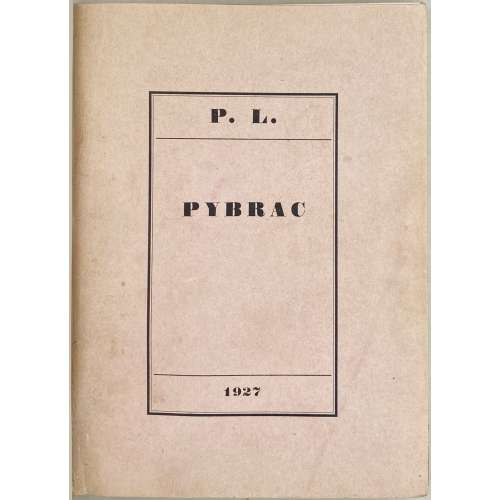 Description: Hardcover, 19.3 x 15 cm, printed on thick wove paper watermarked “J. PERRIGOT MBM ARCHES (France)”, bound by Thomas Boichot (signed 'BOICHOT' on front pastedown) in silver buckram with a white floral diaper, original front wrapper preserved, top margin gilt; engraved bookplate of Roger Peyrefitte by Pierre-Yves Trémois, 1972, to front pastedown lettered “SEX | LIBRIS | ROGER | PEYREFITTE | {vignette} | Trémois | 72”; bookplate of J.-P. Dutel to binder’s flyleaf. Description by the seller: Plein papier à la Bradel, tête dorée, non rogné, premier plat de couverture conservé. (Boichot). Édition originale publiée en 1927 par René Bonnel ornée dans le titre d’une vignette gravée par Foujita. Tirage : 5 ex. sur Japon ancien. 100 ex. sur vélin d’Arches. EXEMPLAIRE UNIQUE. UN DES 100 SUR VÉLIN D’ARCHES (N°97), ENRICHI DE 8 AQUARELLES LIBRES. Provenance: Roger Peyrefitte (Ex-libris érotique gravé par Trémois). Collation: Pink front wrapper, lettered in frame “P. L. |—| PYBRAC |—| 1927”, 2 blank leaves, [1] h.t., [1] t.p. in red and black with engraved vignette by Foujita, [2] (Sur la chemise…), [2] f.t. / blank, [5] 6-98 [2 colophon/blank], 2 blank leaves, total 52 leaves plus four blanks and a wrapper. Title-page (red and black): PIERRE LOUŸS | PYBRAC | POESIES | {vignette} | CYTHÈRE | AU COQ HARDI || Edition: Limited edition of 105 copies of which this is copy № 97 on Arches paper, enhanced with eight in-text colour drawings by an anonymous artist (unique copy). Another unique copy of the same edition illustrated by an anonymous artist in this collection LIB-3130.2023. Contributors: Pierre Louÿs (French, 1870 – 1925) – author. Léonard Tsuguharu Foujita (Japanese-French, 1886 – 1968) – artist (t.p. vignette). Roger Peyrefitte (French, 1907 – 2000) – provenance. Pierre-Yves Trémois (French, 1921 – 2020) – artist (bookplate) René Bonnel (French, 1884 – 1975) – publisher. Thomas Boichot – bookbinder.
Description: Hardcover, 19.3 x 15 cm, printed on thick wove paper watermarked “J. PERRIGOT MBM ARCHES (France)”, bound by Thomas Boichot (signed 'BOICHOT' on front pastedown) in silver buckram with a white floral diaper, original front wrapper preserved, top margin gilt; engraved bookplate of Roger Peyrefitte by Pierre-Yves Trémois, 1972, to front pastedown lettered “SEX | LIBRIS | ROGER | PEYREFITTE | {vignette} | Trémois | 72”; bookplate of J.-P. Dutel to binder’s flyleaf. Description by the seller: Plein papier à la Bradel, tête dorée, non rogné, premier plat de couverture conservé. (Boichot). Édition originale publiée en 1927 par René Bonnel ornée dans le titre d’une vignette gravée par Foujita. Tirage : 5 ex. sur Japon ancien. 100 ex. sur vélin d’Arches. EXEMPLAIRE UNIQUE. UN DES 100 SUR VÉLIN D’ARCHES (N°97), ENRICHI DE 8 AQUARELLES LIBRES. Provenance: Roger Peyrefitte (Ex-libris érotique gravé par Trémois). Collation: Pink front wrapper, lettered in frame “P. L. |—| PYBRAC |—| 1927”, 2 blank leaves, [1] h.t., [1] t.p. in red and black with engraved vignette by Foujita, [2] (Sur la chemise…), [2] f.t. / blank, [5] 6-98 [2 colophon/blank], 2 blank leaves, total 52 leaves plus four blanks and a wrapper. Title-page (red and black): PIERRE LOUŸS | PYBRAC | POESIES | {vignette} | CYTHÈRE | AU COQ HARDI || Edition: Limited edition of 105 copies of which this is copy № 97 on Arches paper, enhanced with eight in-text colour drawings by an anonymous artist (unique copy). Another unique copy of the same edition illustrated by an anonymous artist in this collection LIB-3130.2023. Contributors: Pierre Louÿs (French, 1870 – 1925) – author. Léonard Tsuguharu Foujita (Japanese-French, 1886 – 1968) – artist (t.p. vignette). Roger Peyrefitte (French, 1907 – 2000) – provenance. Pierre-Yves Trémois (French, 1921 – 2020) – artist (bookplate) René Bonnel (French, 1884 – 1975) – publisher. Thomas Boichot – bookbinder. -
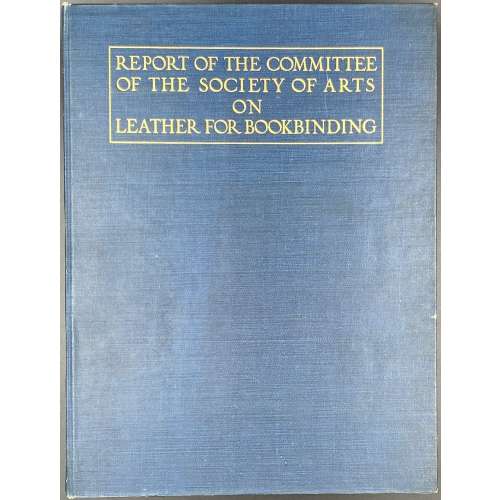 Description: hardcover, 25.2 x 19.2 cm, 8vo, dark blue cloth, gilt lettering in a frame to cover and gilt lettering to spine; captured leather samples pasted to front and back pastedowns, grey endpapers, colour frontispiece, 10 colour plates, multiple in-text b/w illustrations. Collation: a1 blank, a2 h.t./imprint, colour frontis. pasted in, a3 t.p./blank, a4 committee/blank; b2, (no A), B-H8, I5 (10 leaves H1 – I2 with colour plates pasted in, I5 colophon/blank); pagination starts at B2: [1] 2-120 [2]; total a4 b2 B-H8 I5 =67 leaves, 11 colour plates, incl. frontispiece. Title-page: REPORT OF THE COMMITTEE | ON | LEATHER FOR BOOKBINDING. | EDITED FOR | THE SOCIETY OF ARTS | AND | THE WORSHIPFUL COMPANY OF LEATHERSELLERS | BY | THE RT. HON. VISCOUNT COBHAM | CHAIRMAN OF THE COMMITTEE | AND | SIR HENRY TRUEMAN WOOD, M.A. | SECRETARY OF THE SOCIETY | LONDON : | PUBLISHED FOR THE SOCIETY OF ARTS | BY GEORGE BELL & SONS, | YORK HOUSE, PORTUGAL STREET, W.C. | — | 1905 || Contributors: Authors:
Description: hardcover, 25.2 x 19.2 cm, 8vo, dark blue cloth, gilt lettering in a frame to cover and gilt lettering to spine; captured leather samples pasted to front and back pastedowns, grey endpapers, colour frontispiece, 10 colour plates, multiple in-text b/w illustrations. Collation: a1 blank, a2 h.t./imprint, colour frontis. pasted in, a3 t.p./blank, a4 committee/blank; b2, (no A), B-H8, I5 (10 leaves H1 – I2 with colour plates pasted in, I5 colophon/blank); pagination starts at B2: [1] 2-120 [2]; total a4 b2 B-H8 I5 =67 leaves, 11 colour plates, incl. frontispiece. Title-page: REPORT OF THE COMMITTEE | ON | LEATHER FOR BOOKBINDING. | EDITED FOR | THE SOCIETY OF ARTS | AND | THE WORSHIPFUL COMPANY OF LEATHERSELLERS | BY | THE RT. HON. VISCOUNT COBHAM | CHAIRMAN OF THE COMMITTEE | AND | SIR HENRY TRUEMAN WOOD, M.A. | SECRETARY OF THE SOCIETY | LONDON : | PUBLISHED FOR THE SOCIETY OF ARTS | BY GEORGE BELL & SONS, | YORK HOUSE, PORTUGAL STREET, W.C. | — | 1905 || Contributors: Authors:Society of Arts (Great Britain)
Charles George Lyttleton Cobham (British, 1842 – 1922)
Henry Trueman Wood (British, 1879 – 1917), Secretary of the Royal Society of Arts (1879–1917).
George Bell & Sons – publisher. William Clowes and Sons – printer. -
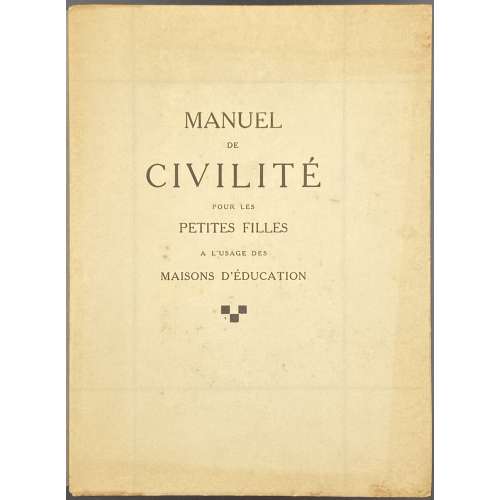 Softcover, collated 8vo, 19.5 x 14.2 cm, French flapped wrappers, lettering to front: MANUEL | DE | CIVILITÉ | POUR LES | PETITES FILLES | À L’USAGE DES | MAISONS D’ÉDUCATION | {checks} ||; printed on BFK Rives wove paper with watermark, with blue vertical and horizontal lines to imitate notebook checkered paper; pp.: [8] [1-15] 16-177 [7]; π4 1-118 124; total 96 leaves (192 pages), incl. those in wrappers. Cardboard double slipcase with vellum spine lettered in black: MANUEL | DE | CIVILITÉ | POUR | LES PETITES | FILLES ||. Title-page: similar to cover, within the frame: MANUEL | DE | CIVILITÉ | POUR LES | PETITES FILLES | À L’USAGE DES | MAISONS D’ÉDUCATION | {checks} || Edition: 1st clandestine limited edition of 600 copies of which 1 copy on papier de chine (№ 1), 15 copies on japon impérial (№№ 2-16), 20 copies on papier de Hollande (№№ 17-36), and 564 copies on vélin de Rives (№№ 37-600) ; this is copy № 473. Enrichment: Accompanied by 5 loose sheets of thin paper blind stamped in the upper-left corner “WHATMAN” with pencil and watercolour drawings, one on both sides, unsigned. Insert two printouts from the previous sellers. Catalogue raisonné: Pia 800/801; Dutel (III) 1916 (indicates 180 pp.). Nordmann II 315 describes copy № 246 illustrated with 86 compositions by Rojankovsky, all signed by Rojan. Later edition, see: LIB-2972.2022. Contributors: Pierre Louÿs (French, 1870 – 1925) Feodor Rojankovsky [Rojan, Фёдор Степанович Рожанковский] (Russian-American, 1891 – 1970).
Softcover, collated 8vo, 19.5 x 14.2 cm, French flapped wrappers, lettering to front: MANUEL | DE | CIVILITÉ | POUR LES | PETITES FILLES | À L’USAGE DES | MAISONS D’ÉDUCATION | {checks} ||; printed on BFK Rives wove paper with watermark, with blue vertical and horizontal lines to imitate notebook checkered paper; pp.: [8] [1-15] 16-177 [7]; π4 1-118 124; total 96 leaves (192 pages), incl. those in wrappers. Cardboard double slipcase with vellum spine lettered in black: MANUEL | DE | CIVILITÉ | POUR | LES PETITES | FILLES ||. Title-page: similar to cover, within the frame: MANUEL | DE | CIVILITÉ | POUR LES | PETITES FILLES | À L’USAGE DES | MAISONS D’ÉDUCATION | {checks} || Edition: 1st clandestine limited edition of 600 copies of which 1 copy on papier de chine (№ 1), 15 copies on japon impérial (№№ 2-16), 20 copies on papier de Hollande (№№ 17-36), and 564 copies on vélin de Rives (№№ 37-600) ; this is copy № 473. Enrichment: Accompanied by 5 loose sheets of thin paper blind stamped in the upper-left corner “WHATMAN” with pencil and watercolour drawings, one on both sides, unsigned. Insert two printouts from the previous sellers. Catalogue raisonné: Pia 800/801; Dutel (III) 1916 (indicates 180 pp.). Nordmann II 315 describes copy № 246 illustrated with 86 compositions by Rojankovsky, all signed by Rojan. Later edition, see: LIB-2972.2022. Contributors: Pierre Louÿs (French, 1870 – 1925) Feodor Rojankovsky [Rojan, Фёдор Степанович Рожанковский] (Russian-American, 1891 – 1970). -
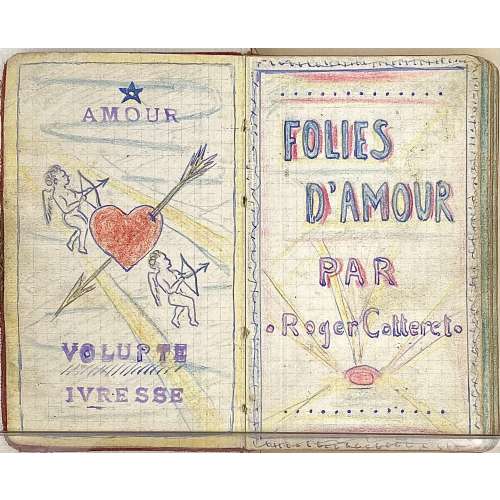 Lavishly illustrated manuscript bound in brown cloth with a red cloth border, 12.3 x 7.5 x 1.6 cm, green marbled endpapers with the inscription “Mein | Kampf” to free leaf, front pastedown with a pocket; written with blue ink and drawn with colour crayons on checkered notepaper with rounded corners, unpaginated, 104 leaves total. Frontispiece: ☆ | AMOUR | {two cupids and a heart pierced with an arrow, sunbeams} | VOLUPTE | IVRESSE || Title-page: FOLIES | D'AMOUR | PAR | • Roger Cotteret • | {raising sun and sunbeams} | row of dots || A copy of the whole manuscript is presented here.
Lavishly illustrated manuscript bound in brown cloth with a red cloth border, 12.3 x 7.5 x 1.6 cm, green marbled endpapers with the inscription “Mein | Kampf” to free leaf, front pastedown with a pocket; written with blue ink and drawn with colour crayons on checkered notepaper with rounded corners, unpaginated, 104 leaves total. Frontispiece: ☆ | AMOUR | {two cupids and a heart pierced with an arrow, sunbeams} | VOLUPTE | IVRESSE || Title-page: FOLIES | D'AMOUR | PAR | • Roger Cotteret • | {raising sun and sunbeams} | row of dots || A copy of the whole manuscript is presented here. -
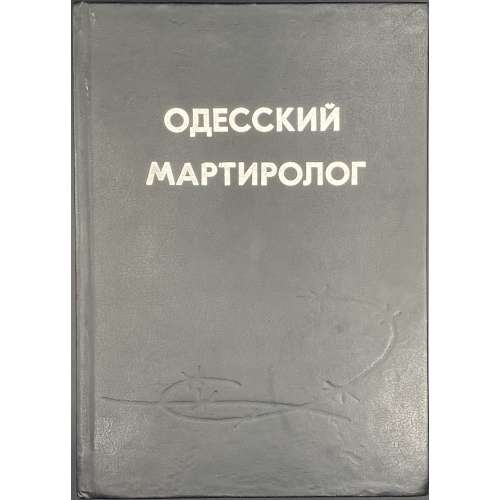 Hardcover volume, 24.2 x 17.2 cm, bound in black buckram with blind barbed wire design and silver lettering to front cover and spine, pp.: [2] 3-892 [4]. Одеський мартиролог: Данi про репресованих Одеси i Одеськоï областi за роки радянськоï влады (Серiя «Реабiлiтованi iсторiэю») (Том 3) / Уклад.: Л. В. Ковальчук, Г. О. Разумов— Одеса : ОКФА, 2005. Title-page: Научно-документальная серия книг | «РЕАБИЛИТИРОВАННЫЕ ИСТОРИЕЙ» | ОДЕССКИЙ | МАРТИРОЛОГ | ТОМ 3 | Одесса | ОКФА | 2005 || ISBN: 966-571-124-5 Print run: 1,000 copies. Ковальчук, Лидия Всеволодовна Разумов, Георгий Александрович
Hardcover volume, 24.2 x 17.2 cm, bound in black buckram with blind barbed wire design and silver lettering to front cover and spine, pp.: [2] 3-892 [4]. Одеський мартиролог: Данi про репресованих Одеси i Одеськоï областi за роки радянськоï влады (Серiя «Реабiлiтованi iсторiэю») (Том 3) / Уклад.: Л. В. Ковальчук, Г. О. Разумов— Одеса : ОКФА, 2005. Title-page: Научно-документальная серия книг | «РЕАБИЛИТИРОВАННЫЕ ИСТОРИЕЙ» | ОДЕССКИЙ | МАРТИРОЛОГ | ТОМ 3 | Одесса | ОКФА | 2005 || ISBN: 966-571-124-5 Print run: 1,000 copies. Ковальчук, Лидия Всеволодовна Разумов, Георгий Александрович -
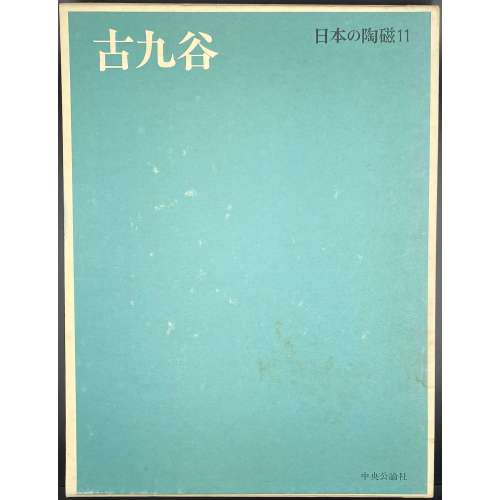 Hardcover volume, 35 x 26.8 cm, bound in grey cloth, blind stamped characters to front, brown characters to spine, in a slipcase, the outer case missing, pp.: [4] [1] 2-136 (plates with photographs of 211 items), [2] 139-166 [4]. Kutani ware [九谷焼] (Kutani-yaki); old kutani [古九谷] (kokutani) – ceramic objects produced in Kutani in the 17th century. 日本の陶磁 – Japanese ceramics, series title. Contributors: Yasunari Kawabata [川端 康成] (Japanese, 1924 – 1972) – author. Tetsuzo Tanikawa [谷川 徹三] (Japanese, 1895 – 1989) – author. Seizo Hayashiya [林屋晴三] (Japanese, 1928 – 2017) – editor. Chūōkōron-sha [中央公論社] – publisher.
Hardcover volume, 35 x 26.8 cm, bound in grey cloth, blind stamped characters to front, brown characters to spine, in a slipcase, the outer case missing, pp.: [4] [1] 2-136 (plates with photographs of 211 items), [2] 139-166 [4]. Kutani ware [九谷焼] (Kutani-yaki); old kutani [古九谷] (kokutani) – ceramic objects produced in Kutani in the 17th century. 日本の陶磁 – Japanese ceramics, series title. Contributors: Yasunari Kawabata [川端 康成] (Japanese, 1924 – 1972) – author. Tetsuzo Tanikawa [谷川 徹三] (Japanese, 1895 – 1989) – author. Seizo Hayashiya [林屋晴三] (Japanese, 1928 – 2017) – editor. Chūōkōron-sha [中央公論社] – publisher. -
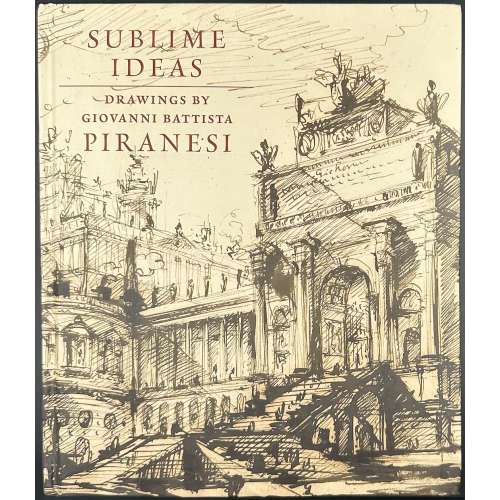 Hardcover volume, 28.7 x 24.7 cm, pictorial paper boards, pictorial endpapers, pp. :[1-6] 7-224, 207 colour ils. Published on the occasion of an exhibition at the Morgan Library & Museum, 10 March to 4 June 2023. Title-page: SUBLIME IDEAS | — | DRAWINGS BY | GIOVANNI BATTISTA | PIRANESI | John Marciari | THE MORGAN LIBRARY & MUSEUM, NEW YORK | in association with | PAUL HOLBERTON PUBLISHING || Contributors: John Marciari (American, b. 1971) – author. Giovanni Battista [Giambattista] Piranesi (Italian, 1720 – 1778) – artist.
Hardcover volume, 28.7 x 24.7 cm, pictorial paper boards, pictorial endpapers, pp. :[1-6] 7-224, 207 colour ils. Published on the occasion of an exhibition at the Morgan Library & Museum, 10 March to 4 June 2023. Title-page: SUBLIME IDEAS | — | DRAWINGS BY | GIOVANNI BATTISTA | PIRANESI | John Marciari | THE MORGAN LIBRARY & MUSEUM, NEW YORK | in association with | PAUL HOLBERTON PUBLISHING || Contributors: John Marciari (American, b. 1971) – author. Giovanni Battista [Giambattista] Piranesi (Italian, 1720 – 1778) – artist. -
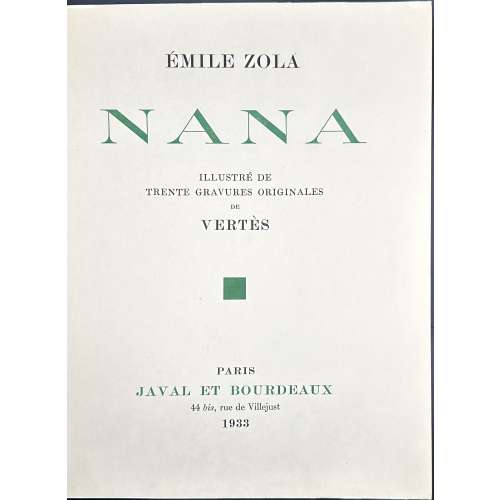 Publisher’s olive French flapped wrappers, in-4to, 33 x 25.3 x 6 cm, green and black lettering to front and spine, in a glassine dust jacket, in a marbled double slipcase 34.5 x 25.5 cm, unbound; pp.: [8] 1-436 [4], plus 30 colour plates with guard tissue, extraneous to collation; edition enriched with a set of 30 uncoloured etchings with guard tissue in a lettered paper folder. Title-page: ÉMILE ZOLA | NANA | ILLUSTRÉ DE | TRENTE GRAVURES ORIGINALES | DE | VERTÈS |◾| PARIS | JAVAL ET BOURDEAUX | 44 bis, rue de Villejust | 1933 || Justification du tirage: il a été tiré de «Nana » d'Émile Zola. Soixante exemplaires sur japon impérial, numérotés de 1 a 60, avec un état en couleurs colorié a la main et un état en noir des trente gravures originales de Vertès. [Edition limited to 60 copies, this is copy № 54]. Colophon: « NANA », D'ÉMILE ZOLA, ÉTÉ ACHEVÉ D'IMPRIMER LE TRENTE AVRIL MIL NEUF CENT TRENTE-TROIS, EN CARACTÈRES ROMAIN ANGLAIS DU CORPS 16, SUR LES PRESSES DU MAITRE IMPRIMEUR COULOUMA, À ARGENTEUIL, H. BARTHÉLEMY, DIRECTEUR. LES COMPOSITIONS DE VERTÈS ONT ÉTÉ REPRODUITES EN FAC-SIMILÉ PAR D. JACOMET & Cie. Printed on April 30, 1933 by Coulouma in Argenteuil, H. Barthélemy, director; illustrations reproduced in facsimile by D. Jacomet & Co. Catalogue raisonné: Vokaer 30. Contributors: Émile Zola (French, 1840 – 1902) – author. Marcel Vertès [Marcell Vértes] (Jewish-Hungarian-French, 1895 – 1961) – artist. Javal et Bourdeaux – publisher. Daniel Jacomet (French, 1894 – 1966) – printer. Seller's description: Nana. Paris, Javal et Bourdeaux, 1933. 2 volumes in-4, en feuilles, non coupé, non rogné, chemise et étui. Ouvrage illustré de 30 gravures originales en couleurs de Marcel Vertès. Tirage à 60 exemplaires sur japon impérial contenant un état des illustrations coloriées à la main en couleurs et un état en noir. Chemise et emboîtage insolés.
Publisher’s olive French flapped wrappers, in-4to, 33 x 25.3 x 6 cm, green and black lettering to front and spine, in a glassine dust jacket, in a marbled double slipcase 34.5 x 25.5 cm, unbound; pp.: [8] 1-436 [4], plus 30 colour plates with guard tissue, extraneous to collation; edition enriched with a set of 30 uncoloured etchings with guard tissue in a lettered paper folder. Title-page: ÉMILE ZOLA | NANA | ILLUSTRÉ DE | TRENTE GRAVURES ORIGINALES | DE | VERTÈS |◾| PARIS | JAVAL ET BOURDEAUX | 44 bis, rue de Villejust | 1933 || Justification du tirage: il a été tiré de «Nana » d'Émile Zola. Soixante exemplaires sur japon impérial, numérotés de 1 a 60, avec un état en couleurs colorié a la main et un état en noir des trente gravures originales de Vertès. [Edition limited to 60 copies, this is copy № 54]. Colophon: « NANA », D'ÉMILE ZOLA, ÉTÉ ACHEVÉ D'IMPRIMER LE TRENTE AVRIL MIL NEUF CENT TRENTE-TROIS, EN CARACTÈRES ROMAIN ANGLAIS DU CORPS 16, SUR LES PRESSES DU MAITRE IMPRIMEUR COULOUMA, À ARGENTEUIL, H. BARTHÉLEMY, DIRECTEUR. LES COMPOSITIONS DE VERTÈS ONT ÉTÉ REPRODUITES EN FAC-SIMILÉ PAR D. JACOMET & Cie. Printed on April 30, 1933 by Coulouma in Argenteuil, H. Barthélemy, director; illustrations reproduced in facsimile by D. Jacomet & Co. Catalogue raisonné: Vokaer 30. Contributors: Émile Zola (French, 1840 – 1902) – author. Marcel Vertès [Marcell Vértes] (Jewish-Hungarian-French, 1895 – 1961) – artist. Javal et Bourdeaux – publisher. Daniel Jacomet (French, 1894 – 1966) – printer. Seller's description: Nana. Paris, Javal et Bourdeaux, 1933. 2 volumes in-4, en feuilles, non coupé, non rogné, chemise et étui. Ouvrage illustré de 30 gravures originales en couleurs de Marcel Vertès. Tirage à 60 exemplaires sur japon impérial contenant un état des illustrations coloriées à la main en couleurs et un état en noir. Chemise et emboîtage insolés. -
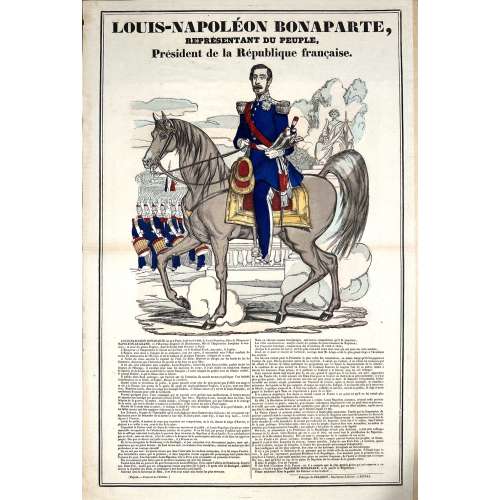 Hand-coloured woodcut poster on wove paper, 622 x 417 mm; black ink stamp “4859” to reverse, horizontal centrefold. In a double frame, top: LOUIS-NAPOLÉON BONAPARTE, | REPRÉSENTANT DU PEUPLE, | Président de la République française. Text under the image ; bottom left: (Déposé.— Propriété de l’Éditeur.); right: Fabrique de PELLERIN, Imprimeur-Libraire, à ÉPINAL. Jean Charles Pellerin (French, 1756 – 1836) – printer/publisher.
Hand-coloured woodcut poster on wove paper, 622 x 417 mm; black ink stamp “4859” to reverse, horizontal centrefold. In a double frame, top: LOUIS-NAPOLÉON BONAPARTE, | REPRÉSENTANT DU PEUPLE, | Président de la République française. Text under the image ; bottom left: (Déposé.— Propriété de l’Éditeur.); right: Fabrique de PELLERIN, Imprimeur-Libraire, à ÉPINAL. Jean Charles Pellerin (French, 1756 – 1836) – printer/publisher. -
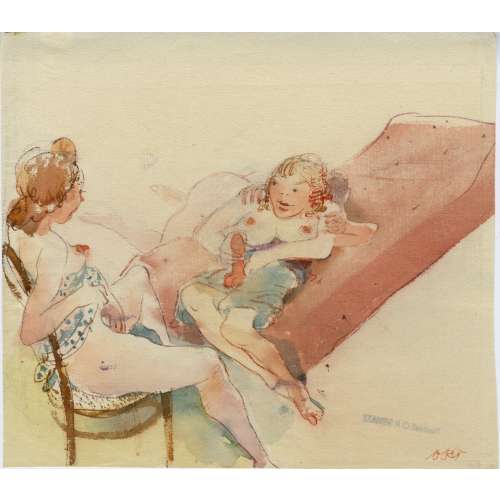 Watercolour on laid paper, 198 x 225 mm, signed or stamped in orange ink “ORS” to recto [Otto Rudolf Schatz (Austrian, 1900 – 1961)]; black ink stamp: “Nachlaß O R SCHATS”, pencil “ss” in the bottom left corner, and remnants of a hinge on the upper right to verso.
Watercolour on laid paper, 198 x 225 mm, signed or stamped in orange ink “ORS” to recto [Otto Rudolf Schatz (Austrian, 1900 – 1961)]; black ink stamp: “Nachlaß O R SCHATS”, pencil “ss” in the bottom left corner, and remnants of a hinge on the upper right to verso. -
 Iron tsuba of quatrefoil form with design of bamboo stems and leaves, and a plank bridge in openwork (sukashi). Hitsu-ana of irregular form. Iron with smooth chocolate patina. Copper and shakudō sekigane. This piece is illustrated in Sasano: Japanese Sword Guard Masterpieces from the Sasano Collection, 1994 on page 295 under № 254 with the following description:
Iron tsuba of quatrefoil form with design of bamboo stems and leaves, and a plank bridge in openwork (sukashi). Hitsu-ana of irregular form. Iron with smooth chocolate patina. Copper and shakudō sekigane. This piece is illustrated in Sasano: Japanese Sword Guard Masterpieces from the Sasano Collection, 1994 on page 295 under № 254 with the following description:Nishigaki. First generation Kanshiro (died in the sixth year of Genroku, 1693, at the age of 81). Sukashi design: Bamboo (take). Early Edo period, late 17th century (Kanbun / Enppo era). Height: 72.6 mm; Width: 71.5 mm; Rim thickness: .6 mm; Centre thickness: 5.1 mm. Rounded rim. The shape of this sword guard is a quatrefoil and the design is arranged in the form of a saddle flap. Two bamboo trunks with leaves comprise the design. Calm, soothing and sophisticated are the features of this artist in his later years. Such characteristics may remind one of the work of the first Hikozo.
Provenance: Sasano Masayuki collection, № 254. What is interesting, and what had been found by Bruce Kirkpatrick, is that in the earlier photograph of the same piece ['Sukashi tsuba - bushido no bi' by Sasano Masayuki, photography by Fujimoto Shihara, 1972 (in Japanese), page 245, №201] we clearly see kebori - linear carving that decorates the bamboo leaves and the planks of the bridge. The said kebori have totally disappeared between 1972 and 1994. The tsuba became absolutely flat! Now we can only speculate about the reasons for such cruel treatment of the artistically and historically important item.
Sukashi tsuba - bushido no bi. Author: Sasano Masayuki, photography: Fujimoto Shihara, 1972 (in Japanese). Page 245, №201.
-

Гоббс Томас. Левиафан или материя, форма и власть государства церковного и гражданского. Предисловие и редакция А. Ческиса. - М.-Л.: Гос.соц.-эконом.из-во (СОЦЭКГИЗ), 1936. - 504 стр.
Тираж 10 000 экз.
Библиотека материализма. Томас Гоббс (1588-1679)ю
-
 Utagawa Toyokuni (歌川豐國); 1769 – 24 February 1825. The kabuki actors Ichikawa Danzo IV as Jiroemon (in draw cape) and Morita Kanya VIII as Buemon. Play 'Oriai Tsuzure no Nishiki', performed at the Moritaza Theater in the 7th month of 1798. Publisher: Eijudo.
Utagawa Toyokuni (歌川豐國); 1769 – 24 February 1825. The kabuki actors Ichikawa Danzo IV as Jiroemon (in draw cape) and Morita Kanya VIII as Buemon. Play 'Oriai Tsuzure no Nishiki', performed at the Moritaza Theater in the 7th month of 1798. Publisher: Eijudo. -
 Iron tsuba of round form decorated with two boar's eyes (inome) and two dragonflies (tombo) in small openwork (ko-sukashi) outlined with brass wire. The plate also decorated with 2 to 5 concentric circular rows of brass dots (nail heads) in ten-zōgan. Center of the plate outlined with the inlaid circular brass wire. The inlaid metal is of red-ish hue, so it may be copper, and not brass. The surface has remnants of lacquer. Ōnin school. Mid Muromachi period, middle of 15th century. Dimensions: Diameter: 90 mm, thickness: 3.2 mm. Notes regarding design: "According to various sources, the dragonfly (tombo) is emblematic of martial success, as various names for the insect are homophones for words meaning "victory". The dragonfly is also auspicious because references in the Kojiki and Nihongi link it in both name and shape to the old kingdom of Yamato." [Merrily Baird. Symbols of Japan. Thematic motifs in art and design. Rizzoli international publications, Inc., 2001, p. 108]. "The dragonfly (tonbo), was also called kachimushi in earlier times, and due to the auspicious literal meaning "victory bug" of the characters of this word it became a popular theme on sword fittings." [Iron tsuba. The works of the exhibition "Kurogane no hana", The Japanese Sword Museum, 2014, p. 13]. Two other cutouts - in the form of what in European tradition symbolizes the heart, on the top and in the bottom of tsuba disc - may have two different explanations. The most usual one, inome - "Heart-shaped pattern, which is said to go back to the shape of a wild boar's eye" [Markus Sesko. Encyclopedia of Japanese Swords. Print and publishing: Lulu Enterprises, Inc., 2014.]. This understanding is shared by Robert Haynes [Robert E. Haynes. Study Collection of Japanese Sword Fittings. Nihon Art Publishers, 2010.] and elsewhere, with an exception of Okabe-Kakuya [Okabe-Kakuya. JAPANESE SWORD GUARDS. Museum of Fine Arts, Boston. In cooperation with the department of Chinese and Japanese art; - 1908, p. 14], who provides the illustration of inome-shaped cut-outs with the following explanation: " The tsuba shown in Fig. 13 approaches a square form with rounded corners and is perforated with Aoi decoration. But this book was written long time ago, when people even at MFA might not know enough...
Iron tsuba of round form decorated with two boar's eyes (inome) and two dragonflies (tombo) in small openwork (ko-sukashi) outlined with brass wire. The plate also decorated with 2 to 5 concentric circular rows of brass dots (nail heads) in ten-zōgan. Center of the plate outlined with the inlaid circular brass wire. The inlaid metal is of red-ish hue, so it may be copper, and not brass. The surface has remnants of lacquer. Ōnin school. Mid Muromachi period, middle of 15th century. Dimensions: Diameter: 90 mm, thickness: 3.2 mm. Notes regarding design: "According to various sources, the dragonfly (tombo) is emblematic of martial success, as various names for the insect are homophones for words meaning "victory". The dragonfly is also auspicious because references in the Kojiki and Nihongi link it in both name and shape to the old kingdom of Yamato." [Merrily Baird. Symbols of Japan. Thematic motifs in art and design. Rizzoli international publications, Inc., 2001, p. 108]. "The dragonfly (tonbo), was also called kachimushi in earlier times, and due to the auspicious literal meaning "victory bug" of the characters of this word it became a popular theme on sword fittings." [Iron tsuba. The works of the exhibition "Kurogane no hana", The Japanese Sword Museum, 2014, p. 13]. Two other cutouts - in the form of what in European tradition symbolizes the heart, on the top and in the bottom of tsuba disc - may have two different explanations. The most usual one, inome - "Heart-shaped pattern, which is said to go back to the shape of a wild boar's eye" [Markus Sesko. Encyclopedia of Japanese Swords. Print and publishing: Lulu Enterprises, Inc., 2014.]. This understanding is shared by Robert Haynes [Robert E. Haynes. Study Collection of Japanese Sword Fittings. Nihon Art Publishers, 2010.] and elsewhere, with an exception of Okabe-Kakuya [Okabe-Kakuya. JAPANESE SWORD GUARDS. Museum of Fine Arts, Boston. In cooperation with the department of Chinese and Japanese art; - 1908, p. 14], who provides the illustration of inome-shaped cut-outs with the following explanation: " The tsuba shown in Fig. 13 approaches a square form with rounded corners and is perforated with Aoi decoration. But this book was written long time ago, when people even at MFA might not know enough... The same interpretation of the said heart-like symbol (aoi leaf) is given at Helen C. Gunsaulus. Japanese sword-mounts in the collection of Field Museum. // Publication 216, Anthropological Series, Volume XVI; Chicago, 1923; p. 54: "This mokkō-formed tsuba recalls the aoi form, perforated as it is with the four aoi leaves." It is possible that the "wild boar's eye" theory was developed by later scholars.
The same interpretation of the said heart-like symbol (aoi leaf) is given at Helen C. Gunsaulus. Japanese sword-mounts in the collection of Field Museum. // Publication 216, Anthropological Series, Volume XVI; Chicago, 1923; p. 54: "This mokkō-formed tsuba recalls the aoi form, perforated as it is with the four aoi leaves." It is possible that the "wild boar's eye" theory was developed by later scholars.
 There is also a theory, supported by Graham Gemmell, saying that: “In simple terms Onin works are decorated Ko-Katchushi tsuba. … But, not content with iron alone, they began to decorate it with what was, in the early Muromachi period, a rare and valuable metal, brass. The Onin workers cut the design into the iron, using narrow channels, cast the brass, piece by piece, and then hammered it into the iron plate as though they were putting together a jigsaw. When complete the tsuba would be black lacquered exactly as the plain iron ones had been, the brass shining dully through it in a way that fulfilled the goal of shibui or restrained elegance.” [Tosogu. Treasure of the samurai. Fine Japanese Sword Fittings from The Muromachi to The Meiji Period, by Graham Gemmell. // Sarzi-Amadè Limited, London, 1991. An exhibition held in London from 21st March to 4th April, 1991]. The following illustration from Helen C. Gunsaulus. Japanese sword-mounts in the collection of Field Museum. // Publication 216, Anthropological Series, Volume XVI; Chicago, 1923; pp. 43 supports the idea.
There is also a theory, supported by Graham Gemmell, saying that: “In simple terms Onin works are decorated Ko-Katchushi tsuba. … But, not content with iron alone, they began to decorate it with what was, in the early Muromachi period, a rare and valuable metal, brass. The Onin workers cut the design into the iron, using narrow channels, cast the brass, piece by piece, and then hammered it into the iron plate as though they were putting together a jigsaw. When complete the tsuba would be black lacquered exactly as the plain iron ones had been, the brass shining dully through it in a way that fulfilled the goal of shibui or restrained elegance.” [Tosogu. Treasure of the samurai. Fine Japanese Sword Fittings from The Muromachi to The Meiji Period, by Graham Gemmell. // Sarzi-Amadè Limited, London, 1991. An exhibition held in London from 21st March to 4th April, 1991]. The following illustration from Helen C. Gunsaulus. Japanese sword-mounts in the collection of Field Museum. // Publication 216, Anthropological Series, Volume XVI; Chicago, 1923; pp. 43 supports the idea.
 Helen C. Gunsaulus' description of the dragonfly emblem is as follows: "This motive, the dragon-fly (akitsu), is generally accepted as a symbol of the kingdom of Japan, and the origin of the idea is traced to the legend recounted in the Kojiki and Nihongo of the Emperor Jimmu's view of the island from mountain top. He is said to have thought the kingdom looked like a dragon-fly touching its tail with its mouth. From this it received its name Akitsu-shima... etc."
Helen C. Gunsaulus' description of the dragonfly emblem is as follows: "This motive, the dragon-fly (akitsu), is generally accepted as a symbol of the kingdom of Japan, and the origin of the idea is traced to the legend recounted in the Kojiki and Nihongo of the Emperor Jimmu's view of the island from mountain top. He is said to have thought the kingdom looked like a dragon-fly touching its tail with its mouth. From this it received its name Akitsu-shima... etc."
-
 Shimizu-Jingo tsuba with a dragon and vajra (on reverse) motif. Unsigned. Possibly, 3rd or 4th master of Shimizu-Jingo family in Higo province. Iron. Low relief carving. Edo period, 1700's. Height: 75.4 mm, Width: 72.2 mm, Thickness at seppa-dai: 4.0 mm
Shimizu-Jingo tsuba with a dragon and vajra (on reverse) motif. Unsigned. Possibly, 3rd or 4th master of Shimizu-Jingo family in Higo province. Iron. Low relief carving. Edo period, 1700's. Height: 75.4 mm, Width: 72.2 mm, Thickness at seppa-dai: 4.0 mm


